When you’re building or managing a fuel delivery app, security should be your top priority, not an afterthought.
Just like fuel powers a vehicle, fuel delivery app security powers user trust and business stability. One small gap in security, and you could be dealing with data leaks, payment fraud, or even legal trouble.
Whether you’re a startup founder, business owner, or tech team lead, this guide is for you. We’ll walk you through the key fuel delivery app security measures, from strong user authentication to secure APIs and payment gateways.
Also, you will get some expert tips to ensure your app's security from day one. Let’s make sure your app isn’t just convenient, but also safe, reliable, and future-ready.
Why is Security Critical in Fuel Delivery Apps?
Running a fuel delivery business through an app sounds convenient, but without the right fuel delivery app security, it can turn risky very quickly. You’re dealing with sensitive user data, real-time location tracking, online payments, and critical delivery schedules.
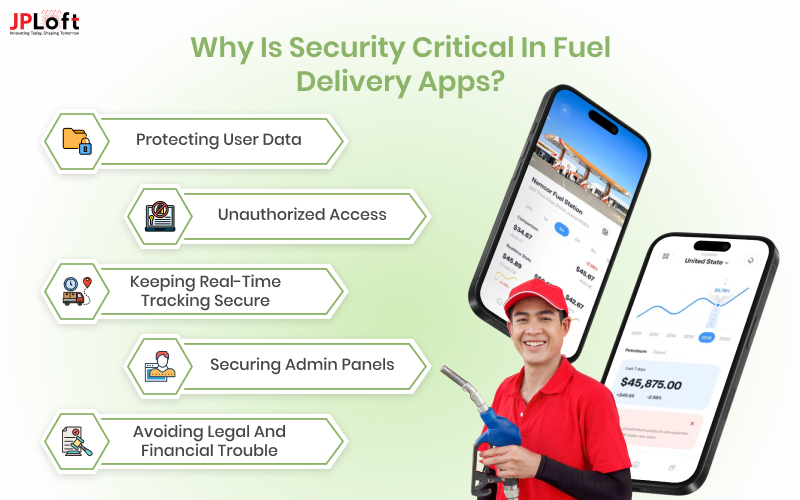
Let’s break down why taking mobile fuel delivery app security seriously is a must:
1. Protecting User Data & Payment Information
While developing a fuel delivery app, you should keep in mind that your app handles a lot of private information, including names, addresses, payment details, and vehicle data.
Without strong fuel app data protection, this info could be exposed to hackers. That’s where mobile app encryption techniques come in. Encrypting user data ensures it stays safe, even if someone tries to access it illegally.
2. Preventing Fraud & Unauthorized Access
Imagine someone using a fake account to place fuel orders or hack into your admin dashboard.
Scary, right? That’s why the best app security measures like multi-factor authentication, biometric login, and secure passwords are important. These are standard fuel delivery app security measures that stop intruders at the gate.
3. Keeping Real-Time Tracking Secure
Your app constantly tracks your drivers and deliveries.
If this tracking gets hijacked, it could put both your team and customers at risk. Strong real-time tracking security and API security in fuel apps help prevent data manipulation and fake delivery updates.
4. Securing Admin Panels and Databases
Your admin panel holds the keys to everything, orders, drivers, customers, and payments.
A weak database structure or exposed API is an open invitation for cyberattacks. Using a secure database for mobile apps and access controls is part of the best security practices every fuel delivery platform should follow.
5. Avoiding Legal and Financial Trouble
Data breaches can cost more than just money; they damage your reputation and could land you in legal trouble. Following app security best practices and complying with industry standards like GDPR and PCI-DSS gives your app a clean record and builds user trust.
In short, the security of the fuel delivery application is the foundation of your business. These on-demand fuel delivery app security measures don’t just guard against risks, they help you grow with confidence.
Understanding the fuel delivery app development challenges, especially around security, is key to building a platform that users can rely on.
Now that we've explored the importance of securing your fuel delivery app, let's dive into some of the common security threats in fuel delivery apps and how you can effectively overcome them to protect your platform and users.
Common Security Threats in Fuel Delivery Apps And How to Overcome Them
The convenience of on-demand fuel delivery apps is undeniable, but with great technology comes great responsibility.
As these platforms handle sensitive user data, payments, and real-time location tracking, fuel delivery app security must be airtight. If ignored, these security gaps can cost you user trust, data integrity, and legal penalties.
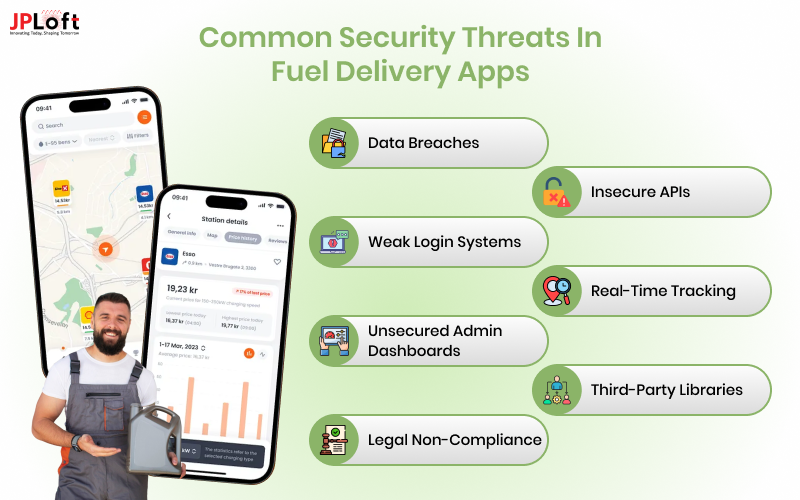
Let’s look at the major security risks in fuel delivery platforms and the best app security measures to address them.
1] Data Breaches: The Silent Threat
Fuel delivery apps collect valuable information, names, addresses, payment details, and vehicle types. If not protected, this data can be targeted by cybercriminals through malware, phishing, or brute-force attacks.
The Solution:
-
- Use mobile app encryption techniques like AES (Advanced Encryption Standard) to encrypt data both at rest and in transit.
- Implement tokenization where sensitive data like card numbers is replaced with dummy tokens.
- Regularly audit your system for vulnerabilities.
- Include app-level firewalls and DDoS protection for extra safety.
These methods ensure that even if data is stolen, it’s unreadable and useless to attackers.
2] Insecure APIs: The Hidden Entry Points
APIs are essential for app functionality, they connect your fuel delivery app to maps, payment gateways, driver management, and more. However, poorly secured APIs are like open doors for hackers.
The Solution:
-
- Use secure API authentication using OAuth 2.0 or API keys.
- Validate all API inputs to avoid injection attacks.
- Implement rate limiting to avoid brute-force attacks.
- Always use HTTPS to secure API calls.
API security in fuel apps helps prevent unauthorized data access and keeps your backend safe.
3] Weak Login Systems: Easy to Break
If users and admins can create weak passwords or access accounts without 2FA (Two-Factor Authentication), your app becomes easy prey for credential stuffing and identity theft.
The Solution:
-
- Enforce strong password rules: a mix of letters, numbers, and symbols.
- Add 2FA using SMS, email OTPs, or biometrics.
- Limit login attempts and implement CAPTCHA.
This adds strong layers to mobile app security for fuel delivery, protecting both users and admins from account hijacking.
4] Real-Time Tracking Manipulation
Top fuel delivery apps rely on real-time tracking to coordinate deliveries. If attackers manipulate GPS data or location feeds, they can redirect deliveries or cause confusion in routing.
The Solution:
-
- Use secure GPS APIs.
- Encrypt location data transmissions.
- Set alerts for abnormal travel patterns or GPS spoofing attempts.
With advanced real-time tracking security, you ensure accurate, tamper-proof delivery routes.
5] Unsecured Admin Dashboards
If your backend dashboard is exposed or easily accessible, attackers can gain full control over jobs, user data, payment logs, and more.
The Solution:
-
- Use role-based access control (RBAC) to restrict dashboard features.
- Only allow IP-based access for admins.
- Add audit trails to monitor all admin actions.
- Always host on a secure server with a secure database for mobile apps.
Admin panels must be treated with the highest level of fuel delivery app security measures.
6] Outdated Code and Third-Party Libraries
Using outdated app frameworks, plugins, or libraries can expose your app to known vulnerabilities.
The Solution:
-
- Perform regular codebase reviews and updates.
- Subscribe to vulnerability alerts for your tech stack.
- Avoid using libraries that are no longer maintained.
The best security practices of fuel delivery apps include staying updated and patched at all times.
7] Legal Non-Compliance
Handling user data comes with responsibilities. If your app fails to comply with data protection laws (like GDPR or Australia's Privacy Act), it can lead to fines, legal notices, and loss of public trust.
The Solution:
-
- Implement user consent pop-ups and privacy policies.
- Allow users to delete or export their data.
- Store only necessary information, and do so securely.
- Ensure compliance with PCI-DSS for payment handling.
Consumer trust comes from transparency, and proper fuel app data protection strengthens that bond.
Now that we’ve discussed the most common threats and their solutions, let’s explore the must-have security features in fuel delivery apps that will protect your platform and give users peace of mind.
Must-Have Security Features in Fuel Delivery Apps
When developing an on-demand fuel delivery app, it’s not enough to just focus on smooth functionality and convenience.
You must also ensure robust fuel delivery app security to gain customer trust and protect sensitive data. From real-time tracking to payment processing, every element must be locked tight with modern security measures.
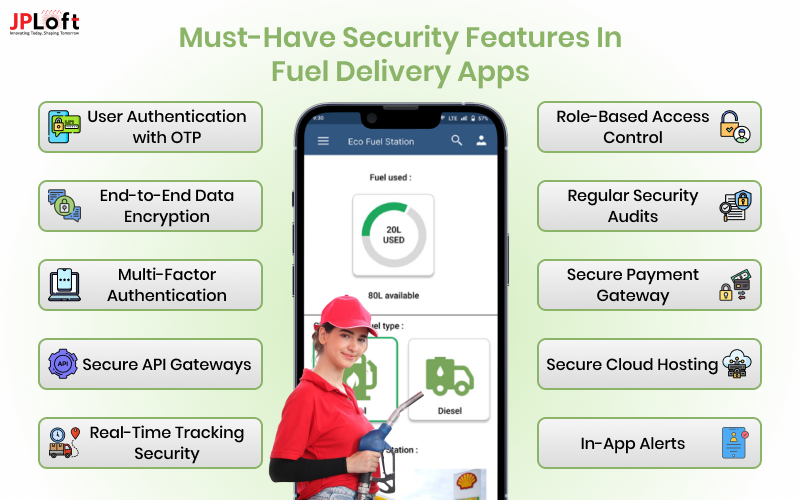
Let’s explore the best security practices and features essential to safeguarding your mobile fuel delivery app.
1. User Authentication with OTP and Biometric Login
Implementing OTP-based logins or biometric verification (like fingerprint or Face ID) is one of the best app security measures to ensure that only authorized users can access the platform.
This feature significantly boosts the fuel delivery app security by adding an extra layer of verification during login, which is especially crucial for on-demand fuel delivery app security.
Benefits:
-
- Enhances mobile app security for fuel delivery by verifying the user's identity in real-time.
- Prevents unauthorized access and reduces the chances of data breaches or fraud.
- Improves user experience by offering fast, secure, and hassle-free login options.
2. End-to-End Data Encryption
One of the best security practices of fuel delivery apps is implementing end-to-end data encryption.
It converts user data, like location, payment, and personal info, into unreadable formats during transfer and storage. Leveraging strong mobile app encryption techniques, such as AES-25,6 ensures your users’ sensitive information is never compromised.
Benefits:
-
- Prevents data breaches and man-in-the-middle attacks.
- Increases trust among customers.
- Supports compliance with data protection regulations.
3. Multi-Factor Authentication (MFA)
A critical fuel delivery app security measure, MFA ensures users verify their identity through a combination of something they know (password), something they have (OTP), or something they are (biometric).
Benefits:
-
- Reduces the risk of unauthorized access.
- Enhances user trust, especially for commercial clients.
- Protects account data from phishing or brute-force attacks.
4. Secure API Gateways
Most mobile apps rely on APIs to connect with payment systems, maps, or user profiles. Implementing API security in fuel apps prevents hackers from injecting malicious code or stealing data through these access points.
Benefits:
-
- Ensures safe communication between components.
- Protects backend infrastructure from exposure.
- Enables better monitoring of suspicious API calls.
5. Real-Time Tracking Security
Tracking delivery vehicles live can open security gaps if not protected. One of the core mobile fuel delivery app security elements is encrypting GPS data and ensuring accurate tracking to avoid spoofing.
Benefits:
-
- Prevents tampering with delivery routes.
- Increases transparency and builds customer confidence.
- Enhances driver accountability.
6. Role-Based Access Control (RBAC)
To reduce internal threats, implement role-based access control so that only authorized users can access specific data or features. It's among the best security practices of fuel delivery apps.
Benefits:
-
- Limit data misuse within your team.
- Simplifies permission management.
- Adds a structured layer of internal app protection.
7. Regular Security Audits and Penetration Testing
Constant assessment is vital. Regular audits and simulated attacks help identify vulnerabilities in your fuel delivery app cybersecurity posture.
Penetration Testing, also known as ethical hacking, involves simulating real-world cyberattacks to test the app’s security defenses.
By hiring cybersecurity experts to attempt to breach the app, you can uncover weaknesses that might not be visible through traditional audits. These tests can target areas like login mechanisms, data storage, APIs, and overall network security.
Benefits:
-
- Uncovers hidden threats before real damage.
- Ensures consistent app stability.
- Keeps your app ready for emerging security challenges.
8. Secure Payment Gateway Integration
Payments are high-stake areas. Using a secure payment gateway integrated with fuel delivery app security measures ensures all transactions are encrypted and PCI-DSS compliant.
Benefits:
-
- Prevents credit card fraud.
- Boosts confidence for recurring app users.
- Maintains compliance with financial regulations.
9. Secure Cloud Hosting and Database Protection
A secure database for mobile apps should include encryption, backup systems, and restricted access layers. Hosting your app on a secure cloud platform like AWS adds extra defense layers.
Benefits:
-
- Prevents accidental leaks or hacking.
- Offers scalable and reliable storage.
- Strengthens the overall infrastructure of your app.
10. In-App Alerts for Suspicious Activity
Enable real-time alerts for irregular login attempts, payment failures, or location changes. This is a simple yet powerful app security best practice.
Benefits:
-
- Detects threats early.
- Allows users to respond immediately.
- Reinforces the image of a secure, proactive app.
Including these fuel delivery app security measures isn’t just about ticking boxes, it’s about building trust, ensuring smooth delivery experiences, and staying legally compliant. Prioritize these fuel delivery app features from day one to protect your users and your brand.
By incorporating these must-have security measures, you ensure that both the app and its users are shielded from potential risks.
However, simply adding features isn’t enough. To truly secure your platform, it’s important to follow best practices throughout the app’s development and operation.
Let’s move forward to dive into some best practices to ensure a secure fuel delivery app that can withstand any security challenges.
Best Practices to Ensure Secure Fuel Delivery App
To stay ahead of rising cybersecurity threats, fuel delivery platforms must adopt more than just basic security features.
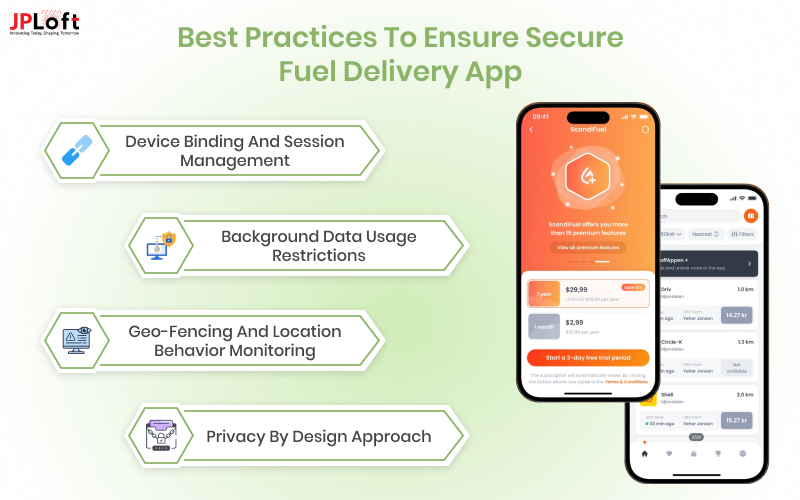
Here are some best security practices of fuel delivery apps that go beyond the usual checklist and strengthen the app’s foundation from a developer and business standpoint.
► Device Binding and Session Management
Enable device binding, so users can log in only from verified devices. Combine this with auto-logout or session expiry features to prevent unauthorized access on unattended devices.
Prevents session hijacking, unauthorized use, and strengthens fuel delivery app security measures.
► Background Data Usage Restrictions
Limit how much data your app processes or stores in the background. Sensitive customer info should only be accessible during active sessions.
This strategy reduces the risk of fuel app data protection breaches from cached or leftover information.
► Geo-Fencing and Location Behavior Monitoring
Use geo-fencing not only for service areas but also to flag suspicious activities. For instance, if a driver accepts a job outside their usual operating zone, the app can flag it for review.
It adds a proactive layer to on-demand fuel delivery app protection and supports real-time tracking security.
► Privacy by Design Approach
Make privacy a core part of your fuel delivery app’s design, not an afterthought. Minimize the data you collect, anonymize it where possible, and give users control over what’s stored.
It builds trust, complies with regulations, and aligns with the latest fuel delivery app cybersecurity standards.
These practices, when combined with the core fuel delivery app security features, create a solid, multi-layered defense system. Remember, the strongest apps are those that prepare for threats before they strike.
As the industry continues to evolve, fuel delivery app trends will shape the future of security features and solutions.
Let’s now take a closer look at the future of fuel delivery app security and what to expect in the coming years.
Future of Fuel Delivery App Security
As technology advances, so must the security of fuel delivery platforms.
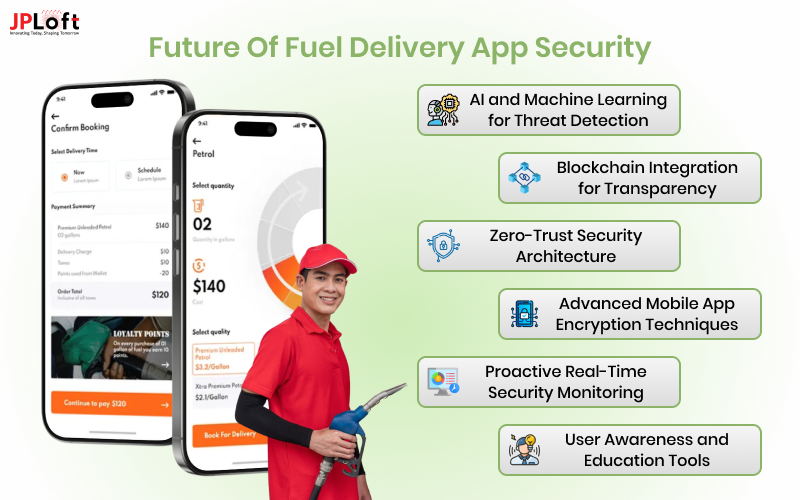
Here’s what the future holds for fuel delivery app security:
-
- AI and Machine Learning for Threat Detection: Future-ready on-demand app protection will use AI in fuel delivery apps to detect unusual behavior, such as unauthorized logins or irregular route patterns. These systems can act instantly to prevent fraud or breaches.
- Blockchain Integration for Transparency: Blockchain can secure payment records and delivery logs by making them tamper-proof. This enhances fuel app data protection and builds trust between the user, driver, and business.
- Zero-Trust Security Architecture: Unlike traditional systems, zero-trust models verify every access request. This approach strengthens fuel delivery app cybersecurity by minimizing internal and external threats.
- Advanced Mobile App Encryption Techniques: Stronger encryption standards will be a must for mobile app security for fuel delivery. It ensures user data, payment info, and delivery locations remain private and secure.
- Proactive Real-Time Security Monitoring: Apps will be able to monitor real-time tracking data and usage patterns to flag any security anomalies immediately, ensuring robust real-time tracking security.
- User Awareness and Education Tools: In-app tips, password guidance, and safety alerts will empower users to take control of their own security. Educated users are less likely to fall for scams or misuse the platform.
The security of fuel delivery applications is shifting from reactive protection to smart, preventive measures, ensuring safer transactions and stronger user trust in the years ahead.
Build a Secure Fuel Delivery App with JPLoft
At JPLoft, we understand that building a fuel delivery app isn’t just about getting fuel from point A to B; it’s about doing it securely, reliably, and with complete user trust. With rising cyber threats and evolving customer expectations, integrating strong security measures is no longer optional, it’s a must.
As a leading fuel delivery app development company, we don’t just code features, we build secure ecosystems.
From robust user authentication systems and encrypted payment gateways to real-time tracking, security, and secure API integrations, our development team ensures your platform is protected from day one.
Whether you’re a startup or an established fuel business looking to go digital, we help you create apps that are fast, secure, scalable, and 100% compliant with industry standards.
Want your fuel delivery app to be safe, smart, and future-proof? Let’s build it together, the secure way.
Final Thoughts
Security is the backbone of any successful on-demand fuel delivery app.
From protecting sensitive user data to ensuring secure transactions and preventing unauthorized access, every layer of your app must be built with strong security in mind.
As we’ve seen, integrating essential features like encryption, secure APIs, real-time tracking protection, and biometric authentication not only safeguards your platform but also builds lasting user trust.
With the growing demand for fuel delivery services, investing in security isn’t just a technical decision, it’s a business strategy. And as threats evolve, so should your app's protection methods.
FAQs
Security is critical in fuel delivery apps because they handle sensitive user data, including payment details and location information. Without proper security measures, your app could become vulnerable to cyberattacks, data breaches, and fraud, which can compromise user trust and damage your business reputation.
Common security risks include unauthorized access, data breaches, weak user authentication, payment fraud, API vulnerabilities, and poor data encryption. Cybercriminals may attempt to exploit these weaknesses, making it crucial to implement proper security protocols.
To ensure your fuel delivery app is secure, implement essential security features like encryption, secure user authentication, real-time tracking, API security, and regular security audits. Additionally, adopting best security practices and staying up-to-date with the latest security trends can significantly reduce potential threats.
Yes, fuel delivery app data can be protected using robust security measures like end-to-end encryption, secure payment gateways, regular audits, and secure APIs. These measures ensure that user data remains confidential and protected from unauthorized access.
To address security vulnerabilities, conduct regular security audits, perform penetration testing, ensure secure communication (e.g., HTTPS), implement secure user authentication, and update your app with the latest security patches and encryption technologies.





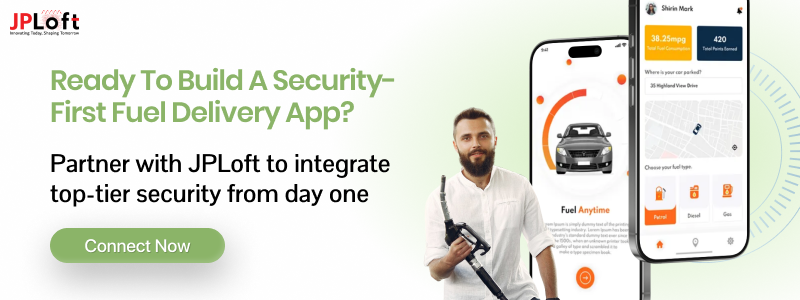
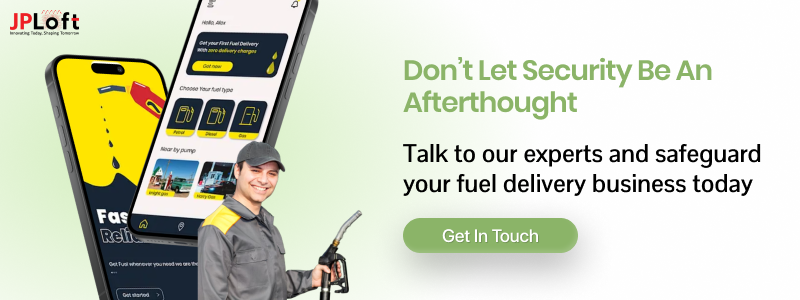

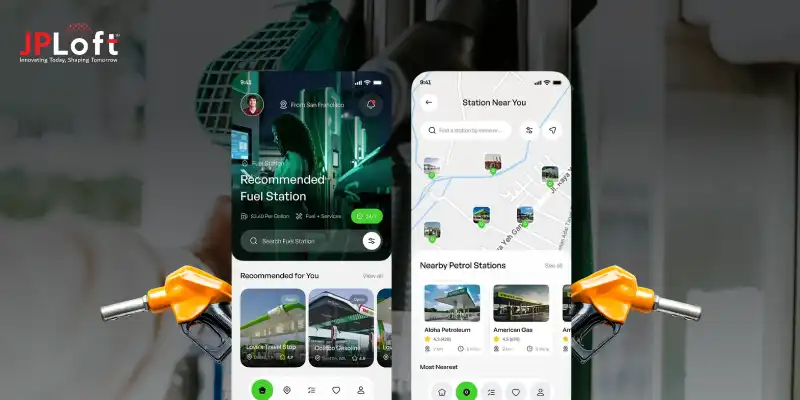
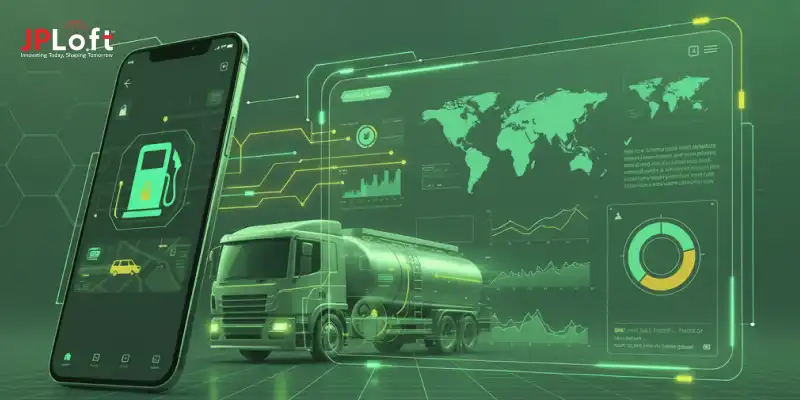
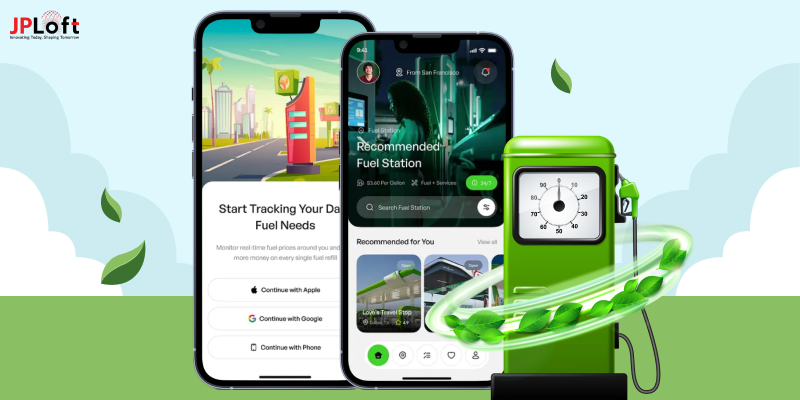


Share this blog